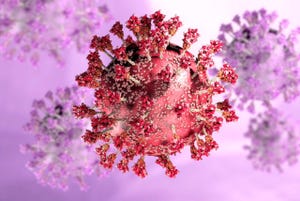Improved Brain Stimulation Device Powered by Metamaterials
November 1, 2013
University of Michigan engineers recently used a so-called metamaterial to construct a magnetic array able to provide finer and deeper brain stimulation than previously possible.
The prototype, recently announced by the university, could potentially lead to transcranial magnetic stimulation coils that are more effective at treating depression or exploring the workings of the human brain.
It also represents another example of the promise metamaterials hold when it comes to medical device design. A metamaterial is an artificial material engineered with precise shape, geometry, orientation and arrangement--with structures often at an exact subwavelength size, smaller than the wavelength of whatever form of energy is affected.
Metamaterials have shown promise in other medical device applications, such as making untrasound imaging high def.
|
University of Michigan engineers are leveraging the unique properties of metamaterials to improve brain stimulation technology. Image credit: Joseph Xu, Michigan Engineering Communications & Marketing. |
They have already shown themselves able to bend light in unusual enough ways that researchers have surmised they could one day be used to make Harry Potter-like invisibility cloaks, if it was ever possible to produce enough of the stuff.
Scientists working at the National Institute of Standards and Technology have even used metamaterials to create a lens that bends and focuses ultraviolet light in such an unusual way that it can create ghostly, 3D images of objects that float in free space--a real-life Star Wars hologram.
In the case of the University of Michigan array, researchers knew they had to go beyond the abilities of the figure-8-shaped, two-coil transcranial magnetic stimulation devices of today.
Present coil systems only send signals 2 centimeters into the brain before the size of the focal spot grows so large that it causes uncomfortable muscle contractions in a patient's scalp, according to Luis Hernandez-Garcia, a research associate professor of biomedical engineering and co-author of a paper on the work published in the October edition of IEEE Transactions on Biomedical Engineering.
"I started working on transcranial magnetic stimulation a while ago and realized the technology was very limited," Hernandez-Garcia says in an article on the University of Michigan's website.
Hernandez-Garcia and others turned to Anthony Grbic, an associate professor of electrical engineering and computer science with experience in metamaterials, who suggested that a surface of loops could do the job.
"These coil arrays are sub-wavelength structures--textured devices designed to manipulate the magnetic near-field in ways that people have never imagined before," Grbic says,
The resulting square array of 64 circular metallic coils changes the shape of the fluctuating magnetic field the coils produce.
Computer simulations show that at 2.4 centimeters field depth, the University of Michigan-created array excited 2.6 times less unwanted brain volume than today's figure 8-shaped devices.
"That improvement isn't marginal," says co-author Eric Michielssen, a professor of electrical engineering and computer science. "This should open up a lot of opportunities to treat depression and other mental illness, as well as probe the brain."
The prototype also needs only one power source--making it easier to use on patients and more affordable to produce. Other so-called multichannel arrays require a power source for each coil.
Not to be confused with electroconvulsive (electric shock) therapy, transcranial magnetic stimulation involves using special coils to create a fluctuating magnetic field that generates a weak electrical field. The electrical field then activates neurons in targeted parts of the brain.
It has been an FDA-approved treatment for depression and other mental illnesses since the latter half of the last decade. But the technology remains relatively crude.
Mayo Clinic's website cautions that the treatment is relatively new, so, "more studies can help determine how effective it is, which treatment techniques work best and whether it has any long-term side effects."
A study early this year in the Journal of the American Medical Association suggests the therapy has promise in treating depression.
And just to provide more fodder for science fiction writers, coils used in the technique have been used to construct brain-to-brain interfaces in which one person can spark small involuntary movements in another person.
Chris Newmarker is senior editor of MPMN and Qmed. Follow him on Twitter at @newmarker.
About the Author(s)
You May Also Like



